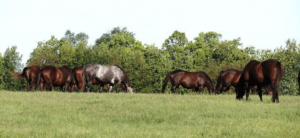 Milkweed toxicity in horses is something horse owners need to be aware of. Monarch butterflies require milkweed to complete their life cycle. However, how are horses best served? By ignoring the ubiquitous plant. Several species of milkweed, a well-known perennial plant, cause poisoning in horses and other livestock, usually when more palatable plants are not available.
Milkweed toxicity in horses is something horse owners need to be aware of. Monarch butterflies require milkweed to complete their life cycle. However, how are horses best served? By ignoring the ubiquitous plant. Several species of milkweed, a well-known perennial plant, cause poisoning in horses and other livestock, usually when more palatable plants are not available.
Milkweed Plants:
Milkweed plants prefer sandy soils. They are along roadways and waterways. They can be opportunistic, thriving in overgrazed areas.
Plants have erect stems, and most species exude a milky sap from leaves and stems when broken or fractured. Plants produce pods, which contain many seeds, each with silky white filaments attached. Both narrow-leafed (1-1.5 inches) and broad-leafed (2.5-5 inches) species have been identified. The narrow-leafed varieties appear to be most toxic.
The principle toxin in milkweed is galitoxin. Where is is found? In all vegetative parts of the plant. Including the leaf, stem, and root. Additionally, milkweed contains cardiac glycosides, which also contributes to toxicosis.
Ingestion of as little as 0.1% of body weight—or 1 lb (0.45 kg) for a 1,000-lb (450-kg) horse—of narrow-leafed milkweed may cause toxicity and death. Clinical signs of toxicity include profuse slobbering, incoordination, colic, irregular heartbeat, and violent seizures.
Because of widespread distribution, milkweed is likely to find its way into paddocks and pastures intended for horses. Like most toxic plants, the best defense against milkweed propagation is a weed-management strategy that includes frequent mowing and application of safe, effective herbicides. Proliferation of milkweed in hayfields is also problematic. The milkweed toxins are not lost. Not even once plants dry. Hence, contaminated hay is potentially dangerous to horses.
In Conclusion:
Have you found milkweed in your turnout area? Can you not rid the area of the weed? Is there little palatable forage in the turnout space?
Horses can be fenced off from the area. They can be fed hay, hay cubes, or hay pellets to satisfy forage requirements. Coupled with an appropriate feed or balancer pellet, horses can thrive on this diet.
J & J Hay can help to answer questions about appropriate diets.
